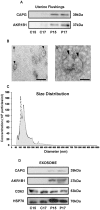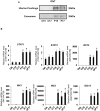Induction of IFNT-Stimulated Genes by Conceptus-Derived Exosomes during the Attachment Period
- PMID: 27351483
- PMCID: PMC4924817
- DOI: 10.1371/journal.pone.0158278
Induction of IFNT-Stimulated Genes by Conceptus-Derived Exosomes during the Attachment Period
Abstract
Biochemical and/or physical communication between the conceptus and the uterine endometrium is required for conceptus implantation to the maternal endometrium, leading to placentation and the establishment of pregnancy. We previously reported that in vitro co-culture system with bovine trophoblast CT-1 cells, primary uterine endometrial epithelial cells (EECs), and uterine flushings (UFs) mimics in vivo conceptus attachment process. To identify molecules in UFs responsible for this change, we first characterized protein contents of UFs from day 17 cyclic (C17) and pregnant (P17) ewes through the use of two dimensional-Polyacrylamide Gel Electrophoresis (2D-PAGE), followed by Liquid Chromatography-tandem Mass Spectrometry (LC-MS/MS) analysis. These analyses identified 266 proteins specific for P17 UFs, from which 172 proteins were identified as exosomal proteins. Among 172 exosomal proteins, 8 proteins that had been identified as exosomal proteins were chosen for further analysis, including macrophage-capping protein (CAPG), aldo-keto reductase family 1, member B1 protein (AKR1B1), bcl-2-like protein 15 (BCL2L15), carbonic anhydrase 2 (CA2), isocitrate dehydrogenase 2 (IDH2), eukaryotic translation elongation factor 2 (EEF2), moesin (MSN), and ezrin (EZR). CAPG and AKR1B1 were again confirmed in P15 and P17 UFs, and more importantly CAPG and AKR1B1, mRNA and protein, were found only in P15 and P17 conceptuses. Moreover, exosomes were isolated from C15, C17, P15, or P17 UFs. Only P15 and P17 exosomes, originated from the conceptus, contained interferon tau (IFNT) as well as CAPG and AKR1B1, and up-regulated STAT1, STAT2, MX1, MX2, BST2, and ISG15 transcripts in EECs. These observations indicate that in addition to endometrial derived exosomes previously described, conceptus-derived exosomes are present in UFs and could function to modify endometrial response. These results suggest that exosomes secreted from conceptuses as well as endometria are involved in cell to cell interactions for conceptus implantation to the maternal endometrium.
Conflict of interest statement
Figures





Similar articles
-
Ovine conceptuses express phospholipase inhibitory genes on days 14-15 of pregnancy, interacting with IFNT pathways.Reproduction. 2025 Jan 11;169(2):e240286. doi: 10.1530/REP-24-0286. Print 2024 Feb 1. Reproduction. 2025. PMID: 39606929 Free PMC article.
-
IFNT-independent effects of intrauterine extracellular vesicles (EVs) in cattle.Reproduction. 2020 May;159(5):503-511. doi: 10.1530/REP-19-0314. Reproduction. 2020. PMID: 32103820
-
Intrauterine exosomes are required for bovine conceptus implantation.Biochem Biophys Res Commun. 2018 Jan 1;495(1):1370-1375. doi: 10.1016/j.bbrc.2017.11.176. Epub 2017 Nov 28. Biochem Biophys Res Commun. 2018. PMID: 29196267
-
Integration of molecules to construct the processes of conceptus implantation to the maternal endometrium.J Anim Sci. 2018 Jun 29;96(7):3009-3021. doi: 10.1093/jas/sky103. J Anim Sci. 2018. PMID: 29554266 Free PMC article. Review.
-
Ruminant conceptus-maternal interactions: interferon-tau and beyond.J Anim Sci. 2022 Jul 1;100(7):skac123. doi: 10.1093/jas/skac123. J Anim Sci. 2022. PMID: 35772752 Free PMC article. Review.
Cited by
-
The evolving roles of extracellular vesicles in embryo-maternal communication.Commun Biol. 2024 Jun 21;7(1):754. doi: 10.1038/s42003-024-06442-9. Commun Biol. 2024. PMID: 38906986 Free PMC article. Review.
-
LPS Disrupts Endometrial Receptivity by Inhibiting STAT1 Phosphorylation in Sheep.Int J Mol Sci. 2024 Dec 21;25(24):13673. doi: 10.3390/ijms252413673. Int J Mol Sci. 2024. PMID: 39769435 Free PMC article.
-
Theranostic potential of extracellular vesicles in reproductive tracts: implications for recurrent implantation failure.Mol Biol Rep. 2025 May 24;52(1):502. doi: 10.1007/s11033-025-10619-8. Mol Biol Rep. 2025. PMID: 40411714 Review.
-
Altered microRNA composition in the uterine lumen fluid in cattle (Bos taurus) pregnancies initiated by artificial insemination or transfer of an in vitro produced embryo.J Anim Sci Biotechnol. 2024 Sep 13;15(1):130. doi: 10.1186/s40104-024-01083-8. J Anim Sci Biotechnol. 2024. PMID: 39267128 Free PMC article.
-
Predicting the presence of breast cancer using circulating small RNAs, including those in the extracellular vesicles.Cancer Sci. 2020 Jun;111(6):2104-2115. doi: 10.1111/cas.14393. Epub 2020 Apr 23. Cancer Sci. 2020. PMID: 32215990 Free PMC article.
References
-
- Nagaoka K, Sakai A, Nojima H, Suda Y, Yokomizo Y, Imakawa K, et al. A chemokine, interferon (IFN)-gamma-inducible protein 10 kDa, is stimulated by IFN-tau and recruits immune cells in the ovine endometrium. Biol Reprod. 2003; 68: 1413–1421. - PubMed
-
- Nagaoka K, Nojima H, Watanabe F, Chang KT, Christenson RK, Sakai S, et al. Regulation of blastocyst migration, apposition, and initial adhesion by a chemokine, interferon gamma-inducible protein 10 kDa (IP-10), during early gestation. J Biol Chem. 2003; 278: 29048–29056. - PubMed
MeSH terms
Substances
LinkOut - more resources
Full Text Sources
Other Literature Sources
Research Materials
Miscellaneous

